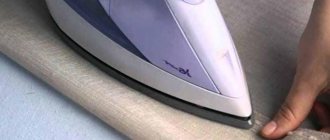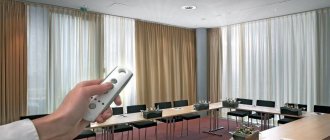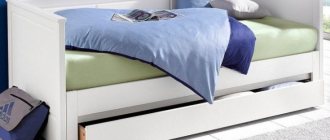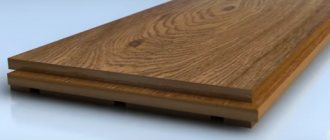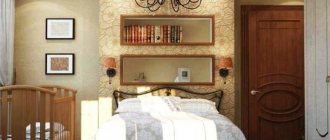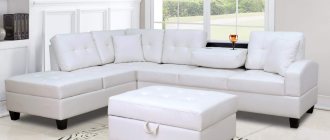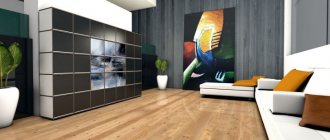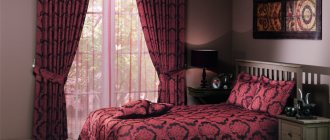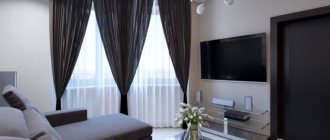Properties of curtain materials
The type of finished window textiles and the room as a whole will depend on the material chosen. Important parameters :
- fabric structure;
- ability to drape;
- resistance to washing, dry cleaning, sunlight;
- ability to absorb odors;
- flammability (for public institutions).
The variety of available fabrics for curtains is expanding with the development of the latest technologies; laser-perforated fabrics have appeared with a unique pattern in light, any photo.
After processing textiles with a special chemical composition, they receive additional properties :
- waterproof;
- protection against burnout;
- non-flammability;
- rigidity;
- crease resistance;
- wear resistance.
Popular fabrics for curtains
Velvet is a heavy fabric with short pile on the front side.
Well suited for curtains with drapery, ideally protects the room from sunlight and noise.
Dry cleaning is recommended, washing is not allowed (the pile becomes wrinkled and the appearance deteriorates).
Chenille is a fabric with a pile on the surface, it can be jacquard (with a pattern of smooth and fluffy threads). Chenille curtains are more suitable for an office, living room, or children's room.
They are dense, form a beautiful drape, hardly wrinkle, protect from sunlight and muffle noise. Dry cleaning recommended .
Jacquard is a material with a two-layer pattern due to the interweaving of threads, this gives it strength and durability.
It looks impressive and is resistant to the damaging effects of sunlight.
Taffeta - curtains made from it are spectacular in the office, the fabric protects from sunlight and looks presentable.
Tapestry is a pleasant-to-touch 100% cotton textile.
It can be painted well in a variety of colors, is suitable for curtains, and is popular with customers.
Criteria for choosing fabrics for curtains
To choose the right fabric, it is important to know what requirements it must meet. Main factors when choosing textiles for curtains :
- purpose of the room;
- interior color scheme;
- ceiling height;
- window size and location.
Depending on the function that the curtains should perform in the room, they can:
- protect from bright sunlight;
- keep warm;
- disguise flaws in the finishing;
- create the effect of a large or small room.
Curtains made of 100% polyester or with a small addition of cotton are more practical.
This fabric does not lose its shape after washing if all recommendations are followed (water temperature not exceeding 40 degrees).
Velvet curtains require only professional cleaning . It is not advisable to hang curtains made of cotton and silk fabrics in a sunny room, as they fade and lose their appearance. Such curtains would not look appropriate in the kitchen.
Satin and jacquard materials are considered traditional and more formal; they can decorate any room and form beautiful folds when draped.
Soft transparent fabrics are used as independent curtains or in combination with heavy draperies. Curtains made of fabric with a printed pattern are suitable for interiors in modern and classic styles.
In a children's room, curtain fabric must meet the basic requirement: practicality. It is better if it is dense, protects well from light, and is easy to wash. It is advisable to use textiles made from natural materials , such as linen, with funny children's drawings.
Advantages of natural materials and care rules
Natural fabrics are environmentally friendly, but difficult to care for and expensive. Therefore, it is better if the curtains are made of natural fabric (linen, chintz, cotton) with an admixture of synthetic fibers.
Cotton
It is considered a safe material because it is made from plant fibers.
Benefits of cotton:
- wear resistance;
- variety of designs;
- breathability;
- affordable cost;
- ease of care;
- environmental friendliness.
Cotton is a safe material.
But cotton curtains fade quickly, wrinkle easily and change color when washed if you do not follow the care instructions.
If the fabric is not treated, shrinkage may occur.
Rules of care:
- Light-colored fabrics can be washed at any temperature; white fabrics can be washed with bleach to achieve a snow-white finish.
- The permissible washing temperature for printed curtains is 40°C. If the fabric is thick, use the 60°C mode.
- To make the material softer, you can rinse it in salted water.
- It is recommended to avoid spinning.
- When overdrying, the fibers are destroyed, so you need to iron a slightly damp fabric or sprinkle it with water before ironing.
Linen
Linen material was once woven by hand. The process is now automated, but production remains labor-intensive and expensive.
High-quality natural fabric is not cheap, but such curtains have many advantages:
- environmental friendliness (natural raw materials do not cause an allergic reaction);
- resistance to sunlight;
- good breathability;
- resistance to stains (linen products do not attract dust, they are easy to wash without chemical stain removers);
- long service life with careful care.
Linen has a long service life.
In addition, linen does not accumulate static electricity, which is important if the curtains are located near household appliances.
The weaknesses of natural fabric are a high degree of shrinkage and poor resistance to aggressive detergents.
Linen curtains are easy to dye, but achieving a rich color is difficult. Most often, customers are offered unbleached fabric of a neutral gray-brown shade, lightened fabric with a yellowish tint, or material imitating burlap.
Basic rules for caring for flax:
- use automatic or hand washing at a temperature of no more than 40°C (if the material is dyed), up to 90°C (for undyed fabrics);
- use only non-aggressive detergents (do not use chlorine and bleaches);
- set the gentle wash mode, do not use the spin cycle;
- hang the material carefully to avoid permanent creases;
- Be sure to iron the linen (it is better to do this through damp gauze).
Silk
Silk is a durable fabric with a glossy sheen that drapes well.
Depending on the weaving characteristics and the quality of the thread, the following types of silk fabrics are distinguished:
- satin - heavy premium material;
- reaper - crepe made of silk threads;
- gas - a material that is used to create decorative elements;
- crepe is a durable, elastic and dense material;
- organza is a tough but lightweight material;
- satin is a more affordable version of satin;
- chiffon is a hypoallergenic, hygroscopic and durable material.
Silk is a soft and durable fabric with a pleasant glossy shine.
Silk fabrics are breathable and hygienic, and have high wear resistance.
But the material is expensive and requires delicate care. It must be protected from sunlight.
Features of caring for silk products:
- machine wash on a delicate cycle;
- use hand wash - in warm soapy water (30°C), without twisting;
- after washing, rinse silk in salted water with vinegar to enhance brightness;
- do push-ups with your hands or in a machine in a gentle mode;
- iron at low temperature, preferably through gauze or a thin damp cloth;
- keep the fabric away from heating devices.
Wool
Wool fabrics are a group of materials in the production of which the natural hair of an animal is used. Fabric can also be obtained by artificial methods (for example, chemically using viscose).
Wool has the following advantages:
- practically does not absorb dust and dirt;
- has high hygroscopicity;
- holds its shape well, elastic;
- Retains heat for a long time.
Wool fabrics are valued for their durability.
The disadvantage is that the wool is delicate and requires special care:
- do not soak the material;
- Only hand wash is allowed;
- wash at water temperature no more than 30°C;
- do not rub or squeeze;
- dry only in a horizontal position;
- iron through a thick damp cloth;
- Do not dry clean.
Fabrics for curtains depending on the interior
Quite often, apartments use a classic version of textile window decoration: two panels made of different materials. Usually a light transparent fabric completely covers the window, with thick curtains on the sides.
Thick fabrics give a feeling of warmth and comfort, while transparent fabrics give a feeling of lightness. To decorate windows, a lambrequin is often used to cover the cornice and part of the curtains. This technique gives the image some completeness.
It is advisable not to use lambrequins in rooms with low ceilings, it looks cumbersome.
An interior in a classic style requires heavy types of materials for curtains: French scallops look impressive, beautifully falling in lush folds.
Roman blinds are more consistent with high-tech style. For the Empire style, it is customary to use expensive fabrics: silk, velvet.
Gold embroidery is possible, especially in combination with purple.
Baroque style - perhaps the most luxurious draperies , multi-layered of expensive and heavy fabrics, and the composition is completed by a complex lambrequin made of intertwining elements.
The decor includes glass beads, fringe, ruffles, curtains are picked up and draped with cords, falling in lush folds to the floor.
When choosing the best fabrics for curtains, it is important that the room reflects the individuality of the occupants.
You can be creative and paint the textiles, decorate them with appliqués or beads. Fabrics have been created with luminescent threads that glow in the dark or with grains that create a luminous pattern on the curtains.
In the dark, such a room looks mysterious and romantic, and the interior is stylish.
Artificial fabrics for kitchen curtains: advantages and features of use
Artificial fabrics are obtained from natural raw materials. Products made from such materials are cheaper than those made from natural fibers and are easy to care for.
Viscose
Viscose is made from waste from wood processing plants with the addition of chemical compounds, so it is a fabric of plant origin. After processing, the material can acquire the properties of cotton, linen, and silk.
Advantages of the fabric:
- has good hygienic properties;
- holds bright colors;
- does not cause an allergic reaction;
- does not accumulate static electricity.
Viscose is a fabric made from natural raw materials, but created artificially.
However, products made from viscose require delicate washing, because... easily deformed and shrink.
Other disadvantages of the material:
- strong creasing (but not mixed with natural fibers);
- loss of strength when wet;
- high percentage of shrinkage;
- exposure to sunlight.
Rules for caring for viscose products:
- machine wash at low speed;
- use temperature conditions up to 40 degrees;
- do not use a spin cycle (including when washing by hand);
- do not iron unnecessarily and do not steam;
- dry flat.
Modal
Modal is a type of viscose made from high quality cellulose (recycled wood). Artificial fabric can be thin and smooth (if the weave of the fibers is 1-sided) or dense, velvety to the touch (if the weave is 2-sided).
Modal is a type of viscose.
Material characteristics:
- preservation of shape (modal does not wrinkle, does not shrink, does not fade);
- high wear resistance and color fastness;
- aesthetic appearance (artificial fabric with one-sided weave resembles matte silk);
- lightness (1 fiber 10 thousand m long weighs 1 g);
- breathability, which makes modal comfortable to use;
- safety, because no toxic substances are used in production.
In rare cases (if the material comes into contact with the skin), modal can cause an allergic reaction.
Rules for caring for modal curtains:
- Wash only by hand or in a delicate cycle in an automatic machine;
- use water temperature no more than 30°C;
- do not spin in the washing machine;
- dry in a horizontal position (can be on a terry towel);
- Iron only from the wrong side and at minimum temperature.
Bamboo
Bamboo fiber is hypoallergenic (it kills up to 70% of bacteria that come into contact with the fabric per day), has high strength combined with breathability (20% higher than cotton), and resistance to wrinkles.
Bamboo is highly durable.
But quality products require careful care:
- wash in a gentle cycle (if the material includes 70% natural fiber, then the standard cycle is allowed);
- use mild detergents without aggressive bleaches;
- Do not use an iron, but you can iron it from the inside out with a warm iron, do not steam.
Acetate
Silk acetate is made from recycled natural wood by treating the cellulose with acetic acid salts.
Positive properties and characteristics of the material:
- does not wrinkle and holds its shape well, can be draped;
- prevents rapid contamination due to its smooth surface;
- provides active air exchange;
- has an affordable price.
Acetate has a smooth surface.
Acetate curtains wear out with regular washing and fade in the sun. The material deteriorates when interacting with aggressive detergents (acids, alkalis).
To ensure that acetate products retain their appearance, you must follow the following care recommendations:
- wash by hand in water whose temperature does not exceed 30°C, or on a gentle cycle in an automatic machine;
- do not use bleaches (can be replaced with hydrogen peroxide);
- do not wring or dry in a machine;
- dry in a horizontal position, avoiding exposure to the sun;
- do not iron (if necessary, it is allowed to do this from the wrong side, through additional fabric, at low temperature).
